In one pivotal scene in Jis Desh Mein Ganga Behti Hai, Kammo (Padmini), the daughter of a dacoit chief tells her naïve beloved that they, the dacoits, are not to be scorned or derided, because they wield guns to make things equal between the rich and the poor. They take from the rich and give to the poor, because the poor have always been preyed upon by the rich.
“Kammoji, tum log chochilist ho?” asks Raju (Raj Kapoor), wide-eyed. Because chochilists, as he informs Kammo, also work to make things ‘barobar’ between the rich and the poor. And when he is reassured that yes, that is the philosophy of the dacoits, Raju decides there and then that he will no longer think of dacoits as evil people.
This romanticised portrayal of dacoits is what puts me off most Hindi daaku films. That, combined with Raj Kapoor (whom I more often than not do not like) and Padmini (a superb dancer, but not among my favourite actresses), made me steer clear of Jis Desh Mein Ganga Behti Hai for years. I knew it had good songs; I’d even heard people praise the film. But I didn’t get around to watching it till a couple of weeks back.
Am I glad I did? Yes, and no. Because there were some pleasant surprises in store for me, but there was also the vindication of some of the fears that I’d harboured from before my viewing of this film.
Jis Desh Mein Ganga Behti Hai introduces us to Raju, an orphan of no known home, who is a bhaand—a minstrel—by profession. Raju is so simple [some—including me—would call him a simpleton] that when, walking through the woods one night he is accosted by a rifle-wielding wounded man (SB Nayampalli) lying on the ground and asked to produce any weapon he may be carrying, all Raju can produce is a fork.
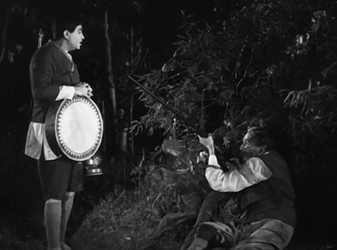
When this makes the wounded man relax enough for him to instruct Raju to bind his bleeding leg for him, Raju obeys, under the impression that he’s rescuing a policeman wounded by the dacoits. At the man’s insistence, Raju helps him into a nearby ruin, and generously gives the man not just a drink from his own carefully-horded little pitcher of Gangajal, but also gives him all of Raju’s own meagre dinner of rotis and turnips.

In the midst of this meal, the man passes out [no, it’s not as if Raju’s cooking is so lethal; it’s just that the man has lost a lot of blood]—and, from out of his clothing spills jewellery. Raju leaps to the conclusion that this man must have been on the run from the dacoits, trying to save whatever little valuables he possessed.
Raju is soon to find out exactly who this mysterious man is, because when Raju steps out of the ruin, he’s captured by a gang of dacoits and dragged off to their hideout among the ravines.
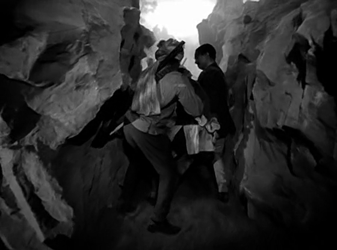
Here, it doesn’t take even a nitwit like Raju long to discover who his hosts are. Raka (Pran), the dacoits’ second-in-command (the man Raju had tended is the chief, the sardar), is convinced that Raju is a police informer—how else would he have chanced upon the sardar? Many of the other men in the gang, including the old Tau (Nana Palsikar) are in agreement with Raka: Raju is certainly an informer, if not a cop himself.
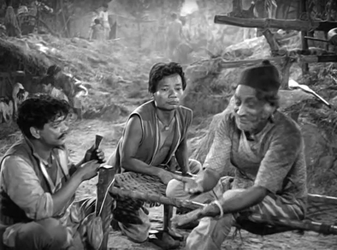
The sardar, however, refuses to accept this. He’s recovered now, and firmly believes that Raju is an innocent, the naïve minstrel he claims to be. After all, would a police informer offer up a fork when asked for a weapon? [it could be a well-thought-out ploy, but that does not seem to occur to the sardar]. Furthermore, says the sardar, he has (literally) eaten Raju’s salt—he cannot turn this man out; he will always be grateful for Raju for saving his life.

Raju will therefore stay there as the sardar’s guest. No end-by date is mentioned, so one may well assume that this means that Raju is going to be staying on here indefinitely. This does not seem to worry Raju, who soon settles in, and swiftly becomes acquainted with the sardar’s daughter, the feisty Kammo. This relationship begins by Raju accidentally colliding with Kammo and being slapped by her, but when she discovers that Raju saved her father’s life, Kammo is quite repentant.
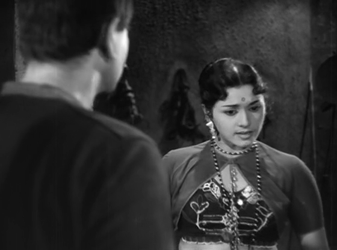
…and soon, she’s the one who scolds the more bullying of the gang’s younger boys when they pick a fight with Raju [yes, Raju is too much of a wimp to even stand up for himself against a bunch of belligerent children]. She also teaches him—with little success—to fire a gun, and soon falls in love with him. And Raju reciprocates in his own naïve, rather childish way.
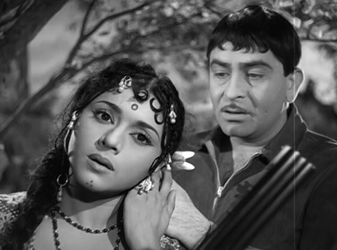
This doesn’t go unnoticed. Raka, who’s had his eye on Kammo for a long time—even though he himself is being assiduously pursued by Bijli (Chanchal)—does not like this budding romance one bit. He already dislikes Raju, and the fact that this country bumpkin has managed to score with Kammo rankles. One evening, when he and the other dacoits have goaded Raju on, there’s an impromptu song-and-dance competition [what do you expect, when among the men playing the dacoits is Herman Benjamin?].
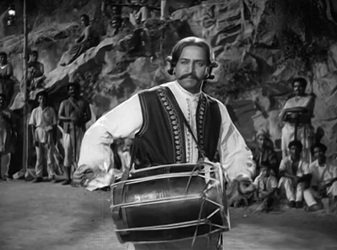
…and Raka realises how he can make use of Raju. There’s an upcoming wedding, that of a wealthy local zamindar’s daughter, and Raka has been informed that the zamindar has had a magnificent and very expensive necklace made for the bride. The dacoits have been planning a raid on nearby Rajgarh for the past few weeks; the wedding is to be held just the day before their raid. It’s too mouthwatering an opportunity to pass up. The gang will mingle with the wedding party and the band, and Raju will be at the forefront, playing his dafli and convincing everyone that this lot really are musicians.
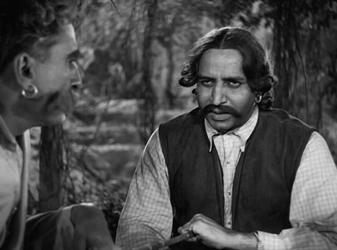
They succeed, and Raju, completely oblivious, wanders around, eating jalebis and watching the wedding ceremony. This is when Raka (who’s in disguise, like most of his men) attacks. There’s instant chaos, with the dacoits firing and looting, while the wedding guests run about trying to escape. In front of Raju’s horrified eyes, the bridegroom is killed, and the dacoits snatch away the bride-widow’s valuable necklace and her mangalsutra. A passing child who happens to come in the way of the fleeing dacoits is also shot dead.
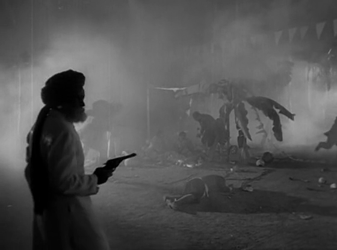
And Raju, finally, realises that these dacoits may not be the harmless chochilists he’d thought them to be. Distraught and disillusioned, he goes off to the Superintendent of Police (Raj Mehra) and informs him that Raka and his gang have just committed this outrage and are planning an attack on Rajgarh. The people of Rajgarh must be protected!
The SP, who’s received confirmation of the attack on the wedding, believes Raju and sends a posse off to Rajgarh. He assures Raju: they will decimate the dacoits.
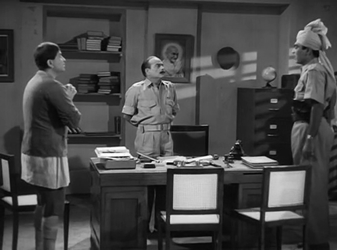
Raju is very distressed. Kill the dacoits? Oh, no, no. Please, no. They are men with wives and children. [Yes, well. How did he expect the police to protect the people of Rajgarh? By evacuating them? By begging the dacoits to leave them alone? Seriously, this man’s stupidity knows no bounds].
As is to be expected, the SP refuses to listen. So Raju does the only thing he can think of: he goes rushing off to stop the dacoits in their tracks, and to warn them that the cops are waiting for them at Rajgarh.

Raka is suspicious, of course. Even more so when Raju readily admits that he was the one who informed the police of the dacoits’ intentions in the first place. Still, Raka sends a man on to check if the police are actually encamped at Rajgarh or not—and the man is promptly killed by the cops.
The dacoits flee, taking Raju with them. Now they’re convinced he is a police informer. Hasn’t he just admitted to it?
Raju’s confession that he tried to plead on behalf of the dacoits to the police—and that he also begged Raka not to send that dacoit on a recce at Rajgarh—however gets him brownie points with the womenfolk and some of the dacoits. His life is spared, but Raju’s tottering faith in the dacoits is shattered when he sees what Raka has gifted Kammo: the necklace that had been snatched from the bride the night of the wedding.

This is too much for Raju. He comes to the conclusion that the dacoits aren’t really chochilists or good people, and even though it breaks his heart, he’ll have to leave Kammo.
Is that it? A brief adventure into a life he thought exemplary, only to discover that it’s far from it? Or is Raju destined to remain with the dacoits, constantly being tossed back and forth between them and the world that lies outside the ravines? Or will Raju himself be the means of a change in the dacoits’ lives?
To my surprise, Padmini, who not only acts well (with barely an accent in most places), but also plays an interesting character. Kammo is an unusual (for Hindi cinema) heroine, in that she’s feisty and stands up for herself—but has the courage, too, to admit when she’s wrong. And her fearlessness does not make her either nasty or any less feminine (another thing Hindi cinema was wont to do in the good old days: equate feistiness with being a tomboy or utterly spoilt). This dauntless-yet-caring trait is also manifested in the other important female character in the film, Mai (played by Lalita Pawar), a doting mother and a devoted wife, but very gutsy.

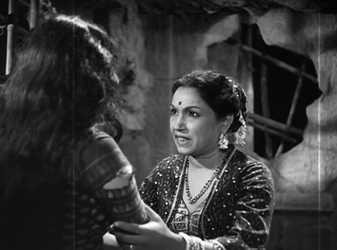
The songs, written by Shailendra and Hasrat Jaipuri and composed by Shankar-Jaikishan. There are some very well-known and popular songs here, including the title song, Aa ab laut chalein, O basanti pawan paagal, and Begaani shaadi mein Abdullah deewaana.
The beauty of its frames. MR Achrekar won the Filmfare Best Art Director Award for Jis Desh Mein Ganga Behti Hai, and if for nothing else, this film is worth watching for its visuals, the striking angles and the stunning landscapes—especially the craggy riverside rocks that lead to the dacoits’s hideout.
Raj Kapoor as Raju, even though he won the Filmfare Best Actor Award for this role. I find Raj Kapoor in his simpleton roles very hard to tolerate, and here he’s at his worst. Raju’s character, on paper, might not be so very irritating: he’s a well-meaning sort, perhaps impossibly naïve but good at heart. On film, though, Raju comes across as being a sanctimonious little idiot who has the brains of a peahen. (The scene where Kammo’s trying to teach him to shoot is ample proof of this character’s brainpower).
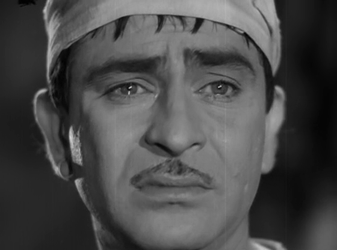
Along the same lines—perhaps fine theoretically, but hard to swallow otherwise—is the entire premise of the film. Jis Desh Mein Ganga Behti Hai (and Raju’s own philosophy) is idealism at its most rose-tinted: as if dacoits, or other criminals with long and bloody records, can be so easily reformed. It’s not as if I oppose reformation; but how logical is it to expect wanted men to decide to give themselves up, en masse? With the sort of records Raka and his men have, even if they aren’t executed, they can probably expect to end up in jail for the rest of their lives. Why, then, would they listen to a nut job like Raju?
Ultimately, not a film I’d want to see again.


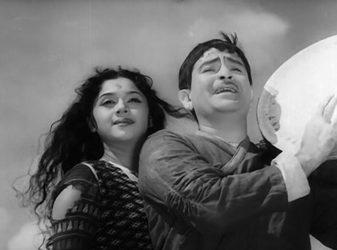

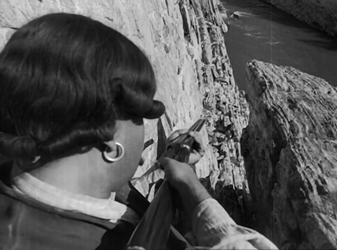
DO, I so completely agree with your entire review of the film. At one point, you said that you thought Raju came across as a “simpleton”. That is the only thing I would disagree with you on. Raj Kapoor actually plays the character as though he is a little retarded. The way he talks is bad enough; but his inability to reason through anything and show IQ greater than that of a fruit fly sends it over the top. He did a much better job of playing a “simpleton” in “Jaagte raho”. While the portrayal in that film does bother me, it does not prevent me from enjoying the film.
In JDMGBH, the redeeming factors are the music (particular songs), Pran and Lalita Pawar were the redeeming factors. I LOVE Lata’s lovely aalaap in the interlude of “Aa ab lauT chaleN” – my favorite song in the film. It is followed closely by “Tum bhi ho hum bhi haiN” and I actually vaguely recall liking the choreography in the song. “O basanti pavan paagal” is a nice one to hear, but I hate the picturization with Padmini’s over-done bosom heaving.
Finally – Padmini. What a lovely face – my own south indian biases may be in play here, but I found her face astounding. However, sadly, she never encountered an emotion that should would not overdo. Tamil cinema is extremely melodramatic and she led the pack in that area. She did tone it down a bit when she transitioned to Hindi cinema, but not even close to enough. Yes, she and her sisters (Lalita and Ragini) were excellent dancers. Sadly, choreography in those days just was not as much an art-form as it has evolved to today.
LikeLike
” The way he talks is bad enough; but his inability to reason through anything and show IQ greater than that of a fruit fly sends it over the top.”
Well, a simpleton is defined as someone who is foolish or silly, so that sorts of fits, doesn’t it? I think Jaagte Raho had RK playing a simple man (as opposed to a simpleton, as here). Fine line, but I think it exists.
Aa ab laut chalein is a lovely song, and I agree that O basanti pawan paagal is probably better heard than seen – Padmini’s bosom does heave rather too dramatically! Talking of Padmini, I have to admit that this is one actress I’ve never been too fond of. I have seen her in several films, but acting and diction don’t seem consistent to me. What puts me off most is the accent which shines through so thickly in a lot of films (not in this one, though). But, a fine dancer, and occasionally a very good actress too.
LikeLike
As usual, a wonderful review, Madhu. And I couldn’t agree more with your take.
So finally you DID watch this one. :-) I also watched it for the first time only last year. I found Raj Kapoor’s character extremely irritating. He’s been a simpleton in many movies but in this one, he really overdoes it.
The songs are really very good, though.They keep coming one after the other – I was just waiting for each song to come along. I love “hum bhi hain, tum bhi ho” – especially Pran’s expressions. Even otherwise I like Pran, but I thought he was really good (and truly evil) in this.
The locations are around Jabalpur, I think. Atul talks often about them. He grew up in that area and he said the shooting took place nearby.
LikeLike
Raja, thank you. And thank you for telling me about the locations being around Jabalpur. I wondered if they might be; those dramatic white rocks towering on both sides of the river reminded me of that area. And it would fit with the setting, anyway – Madhya Pradesh, back then.
Oh, yes. Pran as Raka is really good. One of his most memorable roles, I think.
LikeLike
Hmm… Well, the visuals are stunning, from the beauty of Padmini to the fantastic camera work and sets, the choreography is very pleasing (far different from the crap that I have cringed at in scenes from a few Bollywood films of the present day), Padmini’s dancing is superb, and Padmini plays the tough and feisty character extremely well, in my opinion. What a great breakthrough Hindi film this was for Padmini!
Now, wait a minute, who else was in this?
Just kidding… Raj Kapoor didn’t annoy me that much. And there is, I think, the constant subtle suggestion that there is some intelligence that his character is deliberately hiding as part of an act, as in Shree 420. It’s never really clear that this is what he’s doing, but as I watched this, I felt there was always a hint of that.
The ending is creepy on a political level, because of all this great trust put in the hands of the state. Never mind the unpleasant tendencies of the dacoits! As Philip Lutgendorf said in his excellent writeup:
“But after decades of worsening bureaucratic and high-level corruption, and widely-contested social engineering schemes—including massive displacements of tribal peoples by dams and other development projects—the final triumphalist scenes of repentant dacoit-folk resigned to ‘resettlement’ being rounded up and loaded into open trucks by phalanxes of bayonet-toting soldiers appears more than a little unsettling.”
By the way, I thought that was one of the most insightful reviews at Philip’s site, and I highly recommend it: http://www.uiowa.edu/~incinema/JIS%20DESH%20MEIN.html
I reviewed the film myself, but it was more than a few years ago, and I don’t quite remember what I said. (Maybe I will provide the link later, and anyone can also feel free to search for it on my blog.) I think that most likely, I spent most of the time enthusing about Padmini. (Actually, I recall, I also mulled over some of Philip’s points.)
But right now, I need to go to sleep, because your writeup and my need to respond have kept me up yet further past the time when I should have done so.
Your review was very engaging, Madhu, and your points were good, though taking everything into consideration, my assessment of this film is a bit more positive.
LikeLike
Thank you, Richard! I’m glad you enjoyed the review. I must go to your blog and check out your take on it.
I’m guessing my past probably colours my view of this film and makes me regard it in a bleaker light than most people would. My father was a police officer in the Chambal area during the heyday of dacoits, so I grew up hearing of how dacoits terrorised entire regions… and how a lot of attempts to reform them failed. I do recall my father talking about dacoits turning police informers, though, so it wasn’t as if nobody reformed. (The state pardon and the payment given for informing, of course, would’ve played a part in that instance of reform, of course).
And India, of course, has seen what happened to people like Phoolan Devi… the problem is that even when most dacoits reformed, they’d left behind so many sore and hurting people bent on revenge, that it wasn’t always possible to actually leave the past behind. Forgiving someone who killed your nearest and dearest or maimed you is easier said than done.
I did read Philip Lutgendorf’s take on Jis Desh Mein Ganga Behti Hai, after I’d written my own review. As you point out, too, it’s a very insightful and good review.
LikeLike
Raj Kapoor in his simpleton mode is very hard to bear! That is why I have been avoiding this film like poison for several years, although the visuals from the songs were very enticing.
But somehow I can identify myself with Raju’s dilemma, in that he sees both sides of the story and being trapped in-between is thing, which happens to me quite often. The story as whole does sound good to my idealistic self, though the cynical self might look down at it.
Agree with sangeetbhakt’s opinion on Padmini.
LikeLike
Give it a try, Harvey – who knows, you just might like it! (or at least, not dislike it). The thing that put me off the most was RK’s character, which – as you say, could see both sides of a story and was trapped in the middle – but also resorted to some really tedious and whiny preachiness to try and solve the problem. If he’d been merely someone who empathised both with the law and the dacoits, and could see the advantages of reform, it would have been fine – as long as he behaved in a level-headed way, trying intelligently and diplomatically to help arrive at a resolution. Raju’s way of doing it was just too irritating for me. :-(
LikeLike
Raj Kapoor’s films ARE like that, one does not dislike them (and sometimes likes them, for e.g. Teesri Kasam) despite Raj Kapoor.
Basically he had good ideas and he implemented them also quite well, till he casted himself as the hero.
LikeLike
Basically, I’ve realised I prefer Raj Kapoor when he’s acting in films he’s not produced or directed.
LikeLike
”Jis Desh” was not one of his great movies, however, we will always love THE GREAT RAJ KAPOOR.
LikeLike
Who is the we?
LikeLike
I think as usual I will do with your review rather than watching the film. Yes, Raj Kapoor is an actor I have never been able to like.
LikeLike
Actually, the best parts of the film being the songs and Padmini and the fabulous visuals, you could probably do very well to just watch the songs on Youtube! If you want to, that is.
LikeLike
The dacoit’s lair looks like Shangri La. Fair damsels walk its paved paths, bountiful trees grow there, brooks bubble, children play and families thrive. Such a lovely place. This was the most unbelievable part of the movie.
Raj Kapoor was okay for me. He is like a person who has no prejudices about people. But he has a very strong sense of what is right and what is wrong. And that is what he is guided by.
I loved when both Raj Kapoor and Pran get slapped soundly by Padmini. And the little dance she does with Raj Kapoor’s dafli, after she is charmed by him.
The music is lovely. I loved the Padmini number Kya hua, yeh mujhe kya hua
I did not mind the movie too much, I have seen much much worse.
LikeLike
Hehe! Ava, I love your description of the dacoits’ lair as Shangrila. Absolutely. :-) No wonder they don’t want to leave. And the dacoits breaking into dances at the drop of a hat… hard to swallow.
LikeLike
Oops! I meant this one. I kept waiting for Padmini to jump into the pond in the song I posted above :)
LikeLike
Ah, yes. Ho maine pyaar kiya reminded me, somewhat, in its visuals of Aaja aayi bahaar: falling in love = jumping into a pond and singing about it.
LikeLike
Your review is very good and very much correct about raj kapoor . Raj is a very fine director but not a very good actor. He apes Chaplin . Most of characters he plays are stereotyped and fashioned after Chaplin . Songs and dances by Padmini are outstanding feature of the movie.
Thank you
LikeLike
Epstein, I agree about the Chaplin aping – that is what really puts me off Raj Kapoor. Frankly, in the films where he doesn’t copy Chaplin and is just another actor (like Teesri Kasam or Chori-Chori), I like him.
LikeLike
I would put “Sharda” in this category. There are some excellent moments for Raj Kapoor in this film. Very interesting story-line, unusual for Hindi cinema.
Wasn’t “Awaara” the first film when RK introduced the Charlie Chaplinesque Raju character? His interpretation of the character in that film is actually not irritating at all. It deteriorated consistently over time.
LikeLike
I haven’t yet watched Sharda – mainly because of Raj Kapoor! But now that you’ve given me the go-ahead, I’ll certainly put it on my watch-list. Thanks.
I have to admit most of the early Raj Kapoor films I’ve seen were too, too far back for me to remember much of them. I remember them in their basics, but not much more. You’re probably right about Awara being the one where he adopted the Chaplinesque manner. I think Andaz and Aag predate Awara, but don’t have him acting in that affected sort of way.
LikeLike
Actually, Raj Kapoor has a lot of Chaplinesque mannerisms in Dastan, which was made a year before Awara.
LikeLike
Thank you! I believe I’ve heard of Daastaan, but haven’t seen it. I shall avoid it like the plague. :-)
LikeLike
Ah. :) Your review was very, very good as usual, Madhu. By the way, RK’s character in this is supposed to be a simpleton, so you got that right. And I agree with you about the denouement – that was a tad bit too pat and easy.
But I like RK so it’s hard to read all the RK-hate in the comments, though I know he is not everyone’s cup of tea. :)
LikeLike
Oh, Anu, there’s not all RK-hate in the comments. There’s even someone who’s being rude to everybody who doesn’t like RK!
LikeLike
Madhu,
I enjoyed reading your excellent review. But I could not disagree with you more on some of your conclusions.
Firstly, the vehemence of your criticism of Raj Kapoor. You have fairly accepted that he is not your favourite actor. Could your assessment of his acting in the film have been affected by your dislike of him per se? I have noted there are other readers too with you on this. But, I found him charming. Raju is stupid, has zero IQ, but that is the character he is playing. I did not find his innocence irritating. There is nothing up his sleeve, unlike Raj in Shree 420 as some reader tried to suggest.
Secondly, the climax. I am not a great fan of preachy films with over-the-top idealism, but in JDMGBH there is a great deal of drama in the climax, set in a stunning landscape (which you have mentioned), with a beautiful song Aa ab laut chalen. Is this kind of reformation believable? JP did achieve something of this kind with Chambal dacoits, after which bringing them to the mainstream and rehabilitation became one of the policy instruments to deal with the dacoit problem. A few years earlier, V Shantaram’s Do Ankhen Barah Hath had a theme of reformation which was much more over-the-top and preachy in its idealism. But it was claimed that the movie was based on a real experiment.
If there was one irritant, it was the song Pyar kar le nahi to phaansi chadh jayega and its trite picturisation. Removing this would have made the movie tighter. But, overall this is one of my favourite RK films.
AK
LikeLike
I have never known anyone who dislike Raj Kapoor. You must be a nutter!
LikeLike
There’s no need to be rude, just because others don’t share your likes and dislikes.
LikeLike
AK, I was the one who “tried to suggest” that Raju “had something up his sleeve.” Maybe I was wrong and made assumptions because I had watched Shree 420 not long before this film. But Raju does seem to have the ability to inspire great changes in the characters and a huge political change in the dacoit colony. Where does that come from? Maybe people are just inspired by his innocence? Or maybe he is a sort of idiot savant. Or maybe it just doesn’t make sense. (I guess that is the conclusion that would be reached by Madhu and all the others who don’t like Raj Kapoor.)
Do Ankhen Barah Hath was more overtly preachy in its message, but I liked that Shantaram’s character had to stand up to characters in the administration/government and fight them in order to pursue that gentler path of rehabilitation for the prisoners.
As I said before, I don’t think that the biggest problem with the ending of JDMGBH is the concept that the dacoits could be so easily reformed. The bigger problem is that we are seemingly asked to have faith that the best and wisest justice will be served by, as Philip Lutgendorf, put it, these “phalanxes of bayonet-toting soldiers” who are there to make sure that the dacoits are “rounded up and loaded into open trucks…” Philip got that one absolutely right. Especially seen in the context of more recent history, the sight of those soldiers is much scarier than the sight of dacoits. And the ending also seems to be a little inconsistent with the political perspective shown in earlier Raj Kapoor films.
LikeLike
“The bigger problem is that we are seemingly asked to have faith that the best and wisest justice will be served by, as Philip Lutgendorf, put it, these “phalanxes of bayonet-toting soldiers” who are there to make sure that the dacoits are “rounded up and loaded into open trucks…”
Very well said, Richard. That’s what I’d been trying to say, and you said it for me. Thank you! Yes, the suspension of disbelief is what didn’t sit well with me. I would like to think that Raka and Co. were changed by Raju’s rhetoric, and that they became better people and went on to play a useful role in society… the more realistic side of me questions how that could have happened, and whether the dacoits (and society) would have managed to put their shared past behind them.
LikeLike
My eternal gratitude, AK, for this defence of RK. :)
LikeLike
Thanks, AK, for those observations. Let me try and reply to them (I don’t know if I’ll be very successful, because all said and done, I believe that the appreciation of everything from food to art is subjective).
Firstly: my criticism of Raj Kapoor’s character here. I do not usually like RK, but (as I’ve also mentioned in another comment), it’s not as if I hate RK always. I just don’t like that exaggerated Chaplinesque manner that seems to have endeared him to so many. On the contrary, I like RK when he’s not doing his Chaplin act – as in Teesri Kasam (in which I think his character is a fine example of a man who is simple and even naive, but not stupid). In Jis Desh Mein Ganga Behti Hai, Raju’s naivete borders on what struck me as outright foolishness, which was what irked me. So, no: not a result of RK-dislike. Just a result of a character I couldn’t tolerate. Even if it had been played, in the same style, by one of my favourites – Shammi Kapoor or Dev Anand, for example – I’d still have disliked this character.
As for the climax, I agree that it’s beautifully filmed. Very dramatic. But then (again as I’ve mentioned in my reply to Richard, above) my reaction to that scene is probably coloured by my childhood memories of growing up in a household where we heard very first-hand stories of dacoits. Perhaps that’s made me too cynical.
LikeLike
Madhu, Richard
If you find the ending incredible, I can completely understand it, but I have no problems if it is larger than life, exaggerated and romanticised. We are not looking for ‘realism’ in RK films, but whether he had packaged it in a likeable way. On this count I regard JDMGBH as one of his most charming films.
What I find unsettling is Philip Lutgendorf finding the film ‘unsettling’ for all the political reasons he has cited. I am a great admirer of his reviews, but in this one he really goes overboard in analysing the possible political implications ranging from the British’s classification of criminal tribes, to ‘Sanskritisation’, to Valmiki’s transformation from a bandit to a great poet, to the Indian state being a substitution of the colonial British regime, to the plight of displaced people by big dams! From where did he get all this? It is a RK-school film with lovely music and dance in the backdrop of dacoits who are brought round by a simpleton.
I would not go into the question whether the state is benign or evil. But if the dacoits have to be rehabilitated, can it be done without the state being a necessary player? In all the literature on laissez-faire, the state plays an important and necessary role in creating regulations and legal systems, which implies an assumption that it does so in public interest. With all the caricature of the police and judiciary, Bollywood required the criminals and villains to be handed over to kanoon ke hawaale in the end (at least until the 70s).
AK
LikeLike
AK, if you consider Awara and Shree 420, then I think RK films can be very political. I was greatly drawn to Shree 420 (which I saw first) because it so wonderfully combined song and dance and entertainment for the masses with a sharp critique of capitalism (with all its corruption) and a wary view of the state. Awara was similar in both ways, only more dramatic in its critique of the social status quo.
Philip Lutgendorf pondered how trusting the socialist Raj Kapoor seemed to be of the indian state at the end of JDMGBH, and mulled over so many things that had happened to socialism and the state in much of India since 1960. And I thought that his bringing all those things into his review was not only appropriate, but brilliant. :) .
There was one more point I wanted to answer, but I think I will have to return to that later.
LikeLike
I am glad to see that Madhu we are once again on the same page, I couldn’t agree with you more.
LikeLike
AK, Agree with you on the song ‘pyar karle’, but only on its simplistic picturization, in the ‘jeete-haare saikado’ verse. But ‘chori karee, choor banaa, roj nayee ghaat hain’ verse, with the picturization with Pran and his pals looking back is quite good.
LikeLike
I am once again away attending to some work, so am a little short of time, so am I glad you chose this film for your review, because I do not need to say anything. If I were to say Hindi film style poocho kyun? and you were to poocho kyun I would reply main kya boloon jee Raj Kapoor aur yeh film mujhe bahut bakwas lagee jee HA! HA!. But you know me how I love trivia, so here is a bit of trivial info. Once Hasrat Jaipuri was being interviewed by Tabassum for her programme on Doordarshan. In that programme Jaipuri informed that the censors found a line in the song oh maine pyaar kya offensive and he had to change it. I have a vague memory of the line, I will have to go through the song and I know it will trigger my memory, I am bit busy now so I will come back later with that info, but this much I can tell you it was a very, very harmless line but that member of the censor board obviously had a very vivid imagination. He found it obscene.
LikeLike
Since you like trivia, here is another. There is a similar scenario in the song “Mai soya akhiyaaN meeche” from the film “Phagun”. The line after this is “teri zulfoN ke neeche”. At one point in the song, the lyricist had changed it to “teri baahoN ke neeche”. Our censor board in their infinitely imaginative wisdom found that to be offensive and asked it to be removed. So in the film version of the song, it is replaced with a very horrible sounding instrumental version of the line. It almost seems like O P Nayyar (the composer) was irritated by the censors’ request.
LikeLike
And I have yet another bit of trivia to add along these lines. In Yeh raat yeh fizaayein phir aayein ya na aayein, I’ve heard two versions. Some of the audio versions I’ve heard have the line Yeh narm-si khamoshi, yeh reshmi andhera, kehta hai zulf kholo, jhuk jaayega andhera. The song in the film, however, goes …kehta hai kuchh na bolo, ruk jaayega savera. The censors apparently thought the original line was too risque, and insisted on having it changed.
Actually, if I remember correctly, even the refrain was different – the original being Aao shama bujhaakar hum aaj dil jalaayein (instead of Aao shama jalaakar hum aaj milke gaayein).
LikeLike
And here I thought “Aao shama bujhaakar hum aaj dil jalaayein” was a product of my kiddie imagination, because when I heard it recently, it was “Aao shama jalaakar hum aaj milke gaayein“!
LikeLike
No. not kiddie imagination. Though I think Anu’s and my assertion (expressed over at her blog) that we’d seen the video of Jaata kahaan hai deewaane might be a result of kiddie imagination!
LikeLike
OK I took some time out and I went through the song. You will hear the line manki kali muskayee Jaipuri had originally written bandh kali muskayee the censor board member found it obscene and Jaipuri just could not convince him so he had to bow down and change it to manki kali I am still trying to figure that one out.
LikeLike
Good lord! That’s really silly.
Actually, now that I think of it, it’s probably a case of a dirty mind equating bandh kali to virginity? (I’m guessing).
LikeLike
…but isn’t that the prevalent metaphor? bandh kali, kachhi kali, or just plain kali…
Even in German the same metaphor was used in earlier times. Now everyone would laugh out at such analogies.
BTW, I always thought that it was bandh kali muskayi. I checked it on youtube video, it is man ki kali. Is it once again a audio/video discrepancy.
LikeLike
Actually, come to think of it, a kali would always be bandh, right? Once it’s not bandh, it’s a phool.
LikeLike
exactly!
LikeLike
Yes I guess that is what they thought while from what Jaipuri was saying in that programme, it was clear that he was totally stumped by the attitude of the censors, poor man. What saddens me is that lyricists like Jaipuri, Shailendra, Shakeel, Sahir and so on those days wrote poetry and did not cater to the baser instincts or the front benchers with crude lyrics and imagine these poets being pulled up by the censors.
LikeLike
Hehe! Trust you, Shilpi, to come up with an interesting bit of trivia.
Have you read Anu’s blog post on songs that went missing? Some sad examples there – such as Balma khuli hawa mein – which were axed because a censor thought there was a frame in it that was too obscene (poor Sharmila’s dupatta not draped decorously across her already-clad bosom). How idiotic.
LikeLike
Yes I read it, they can get real ridiculous sometimes.
LikeLike
The songs, Pran (in what he confessed as among his favorite villainous roles of himself, besides as Gajendra in Ram aur Shyam; Sher Khan was his absolute favorite role in his view), and Lalita Pawar are the redeeming factors of this film. I think the whole concept of reformation of Dacoits that this movie hinged on was largely based on what Vinoba Bhave was able to achieve in real life so what this story purports to do is not entirely unrealistic but rather based on what a real man was able to accomplish in real life. Of course, Vinoba Bhave was far more sophisticated than the over-the-top simpleton that RK portrayed in this movie.
RK is unbearable here I confess. The only movie where his naivete was tolerable and even endearing was in Anari. Jagte Raho is also another subtle performance where it was rightly mentioned that he was more of a simple man than a simpleton. I found Jagte Raho such a brilliant and so different from the run-of-the-mill types of movies that Bollywood churns out for the most part. I simply love that movie for its weird yet fascinating story.
LikeLike
I agree with you, Simplegal, about Jaagte Raho. I had my reservations about that film before I watched it (the reservations mainly because of RK), but I ended up liking it a lot. I did find some parts of RK’s character in that too irritating (for instance, he’s so desperate for water, but when it’s within easy reach of him, he stands and goggles…), but by and large, a good film. And with some superb music.
LikeLike
It was Ravishakar Maharaj who devoted his entire life in reforming the decoits especially in Saurashtra, Kathiawad (Gujarat) area and not Vinoba Bhave. Vinoba Bhave in every other way was greater personality, who did wonders in ‘Bhudaan’ (land reforms).
Both were Gandhians.
LikeLike
Madhuji,
I am not a RK fan and I have not watched this movie earlier. After reading your review I watched the movie and I am afraid I did enjoy the film and RK’s role. Padmini and her dancing were fabulous. Pran as usual was at his best in the role of Raka. But Raj Kapoor was naivety personified and I did enjoy his portrayal of this role!
May be my expectations were minimal after reading your review, which can be the reason for my liking the film. Or was Thandpani’s last line (I did not mind the movie too much, I have seen much much worse) more apt! Other readers have commented on the social aspect of this film and do not intend to add anything more.
But the review was good and I enjoyed it.
LikeLike
Thank you, Venkataramanji! I’m glad you enjoyed the review – and I’m glad you enjoyed the film too. We all have our likes and dislikes, and what I may like may not be what others do. And vice-versa. I too agree with thandapani’s assertion that I’ve seen much worse. That is certainly true. Jis Desh Mein Ganga Behti Hai has a lot many redeeming features than a lot of other films of that period.
LikeLike
Ultimately, not a film I’d want to see again.
Once should be enough for some films! Raj Kapoor in his bhola bhaala avatar is unbearable. Its not that he was a bad actor. He just seemed to take his village-idiot-with-Chaplinisque-mannerisms persona so seriously that it grates. I’ve always wondered why filmi simpletons (in films like these) have the monopoly on the moral high ground and world wisdom – as if having a normal IQ automatically makes a person wicked and/or unable to look beyond narrow personal gains!
LikeLike
Hehe! Well said, bollyviewer. Very well said. :-) I do wonder why that bholapan was equated with being good, too. As if one couldn’t be wise and intelligent and also be good at the same time. And RK seems to have made that his signature style.
LikeLike
Fantastic review! had hard time to control my giggles due to “chochilists” and your asides “no, it’s not as if Raju’s cooking is so lethal; it’s just that the man has lost a lot of blood”,” How did he expect the police to protect the people of Rajgarh? By evacuating them? By begging the dacoits to leave them alone? Seriously, this man’s stupidity knows no bounds” :).Anyways,as you rightly observed,Raju’s and his credulousness is quite over the top.But the film is otherwise adorned with beautiful songs such as “O basanti pawan”and “Hoton pe sacchai”.The performances of Lalita Pawar and the Pran are superb.I recall a poignant scene(I have seen this movie long time ago,so could not vividly describe it),when a child draws the noose “phaansi” on his slate and the reactions of Pran and Lalita Pawar on it ,was the best scene of the entire movie,IMHO
LikeLike
Oh, yes, coolone160. That scene with the child drawing the noose is one of the most poignant in the scene. There’s another brilliant one, also with Lalita Pawar, in which she faces up to Raka, who’s been supervising the digging of a hole to bury their loot. When Raka moves away, telling his men to bury the chest they’ve brought, she screams at him “Arre, use kya gaadta hai?” and instead pulls her own son – now fatherless – forward, and shoves him into the hole, telling Raka to bury him. Because he’s as good as dead, anyway. A superb scene.
LikeLike
Yes,indeed….
LikeLike
Interesting discussion. RK evokes strong reactions. I saw it a long time back….Only recollect the brilliant visuals and the great music………i agree with you — RK was a better actor, when directed by others….Anari, chori chori,…even phir subah hogi….i think.. One trivia i read is RK apparently cast Padmini as thank you gesture for taking care of him – when he fell sick in one of his overseas trips — ..
LikeLike
I didn’t know RK cast Padmini out of gratitude. He couldn’t have regretted it, certainly – I think she did a good job here. Very good.
LikeLike
But Raj Kapoor had also known Padmini and the Travancore Sisters for quite some time. According to an article in Rediff (http://www.rediff.com/movies/2006/sep/25padmini1.htm):
The sisters knew Nargis and Raj Kapoor from 1953 onwards. It was at a cricket match between the film stars of Bombay and Madras that they met Nargis. While Padmini scored the highest for Madras, Nargis did so for Bombay. From that day onwards, both became good friends.
When Nargis and Raj Kapoor came to shoot Chori Chori in Madras, Padmini’s mother gave them a house to stay in, close to where the sisters lived. So they used to meet everyday. Nargis used to visit Padmini’s shooting and she would go and see Nargis on the sets…
LikeLike
Interesting! I’d not known that Padmini was good with the bat. I do wonder how much she scored. :-)
LikeLike
here is a video footage of padmini playing cricket with her co stars.
LikeLike
Thank you! That was a treat. I especially loved those last few seconds when they’re all lined up and laughing – so unaffected and being themselves. Very sweet. :-)
LikeLike
the songs and dances were fabulous. Padmini had given outstanding and heart breaking performance..
She was nominated filmfare best actress award for jdmgbh. When nargis left Rk studio, padmini was the first to enter it. Padmini signed this film from moscow, russia.
After this film was released, wherever padmini goes,her fans ask her to say OI HOI HOI…….
LikeLike
I think I’d probably rank this as my favourite Padmini performance so far. She was really good.
LikeLike
“On film, though, Raju comes across as being a sanctimonious little idiot who has the brains of a peahen.”
Yup. Like you, despite the lovely songs and the gorgeous cinematography, Raj Kapoor’s character and performance was enough to sink this film for me forever. Will never watch it again!
LikeLike
Sad, isn’t it? If those fabulous visuals and those great songs had been combined with a really good storyline and an RK who wasn’t acting in that irritating fashion, this might just have been one of those truly unforgettable films…
LikeLike
Is this a Raj Kapoor – hating blog solely for pretentious little creeps ?
LikeLike
i will something different. when i visited bheda ghaat i saw a rock which read a shooting happened here. in jabalpur there was empire talkies of prem nath but it was in very poor condition. we all used to say prem naath ki empire talkies hain. finally it collapsed or was demolished don’t remember. but its glorious days will be remembered always.
LikeLike
i want to mention some movies outside RK where Raj kapoor played tramp roles like khan dost where he was kind hearted hawaldar and one deewana remember of saira banu and him in which he plays a naive man cart driver who falls in love with rich girl. in this movie i want to pin point melodrama when raj kapoor sings honto pay sacchai rehti hain. lalita power expressions are melo dramtic. also i remember this movie for one thing when raju purposes kammo unlike other movies he says mainey ek sapna dekha ki ya mai chahta hu ki aap mere lalla ki maa baney. i think its one of its kind dialogue of purposing. i liked pran raka daku here more than raju.
LikeLike
Pasand apnee apnee, khayaal apnaa apnaa.
IMO, RK carries his ‘simpleton’ role very well, not upstaging Padmini in her feisty role, or Pran in his gangster role. Speaking of Pran, I am surprised you barely mention him!
LikeLike
As you say, pasand apni-apni, khayaal apna-apna. The world would be a boring place if everybody thought alike. And of course I respect your opinion, you have a right to disagree with me.
LikeLike